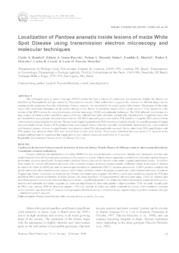Localization of Pantoea ananatis inside lesions of maize white spot disease using transmission electron microscopy and molecular techniques.
Localization of Pantoea ananatis inside lesions of maize white spot disease using transmission electron microscopy and molecular techniques.
Author(s): BOMFETI, C. A.; SOUZA-PACCOLA, E. A.; MASSOLA JUNIOR, N. S.; MARRIEL, I. E.; MEIRELLES, W. F.; CASELA, C. R.; PACCOLA-MEIRELLES, L. D.
Summary: The etiological agent of maize white spot (MWS) disease has been a subject of controversy and discussion. Initially the disease was described as Phaeosphaeria leaf spot caused by Phaeosphaeria maydis. Other authors have suggested the existence of different fungal species causing similar symptoms. Recently, a bacterium, Pantoea ananatis, was described as the causal agent of this disease. The purpose of this study was to offer additional information on the correct etiology of this disease by providing visual evidence of the presence of the bacterium in the interior of the MWS lesions by using transmission electron microscopy (TEM) and molecular techniques. The TEM allowed visualization of a large amount of bacteria in the intercellular spaces of lesions collected from both artificially and naturally infected plants. Fungal structures were not visualized in young lesions. Bacterial primers for the 16S rRNA and rpoB genes were used in PCR reactions 10 amplify DNA extracted from water-soaked (young) and necrotic lesions. The universal fungal oligonucleotide ITS4 was also included to identify the possible presence of funga! structures inside lesions. Positive PCR products from water-soaked lesions, both from naturally and artificially inoculated plants, were produced with bacterial primers, whereas no amplification was observed when ITS4 oligonucleotide was used. On the other hand, DNA amplification with ITS4 primer was observed when DNA was isolated from necrotic (old) lesions. These results reinforced previous report of P. ananatis as the primary pathogen and the hypothesis that fungal species may colonize lesions pre-established by P. ananatis.
Publication year: 2008
Types of publication: Journal article
Unit: Embrapa Maize & Sorghum
Observation
Some of Embrapa's publications are published as ePub files. To read them, use or download one of the following free software options to your computer or mobile device. Android: Google Play Books; IOS: iBooks; Windows and Linux: Calibre.
Access other publications
Access the Agricultural Research Database (BDPA) to consult Embrapa's full library collection and records.
Visit Embrapa Bookstore to purchase books and other publications sold by Embrapa.

